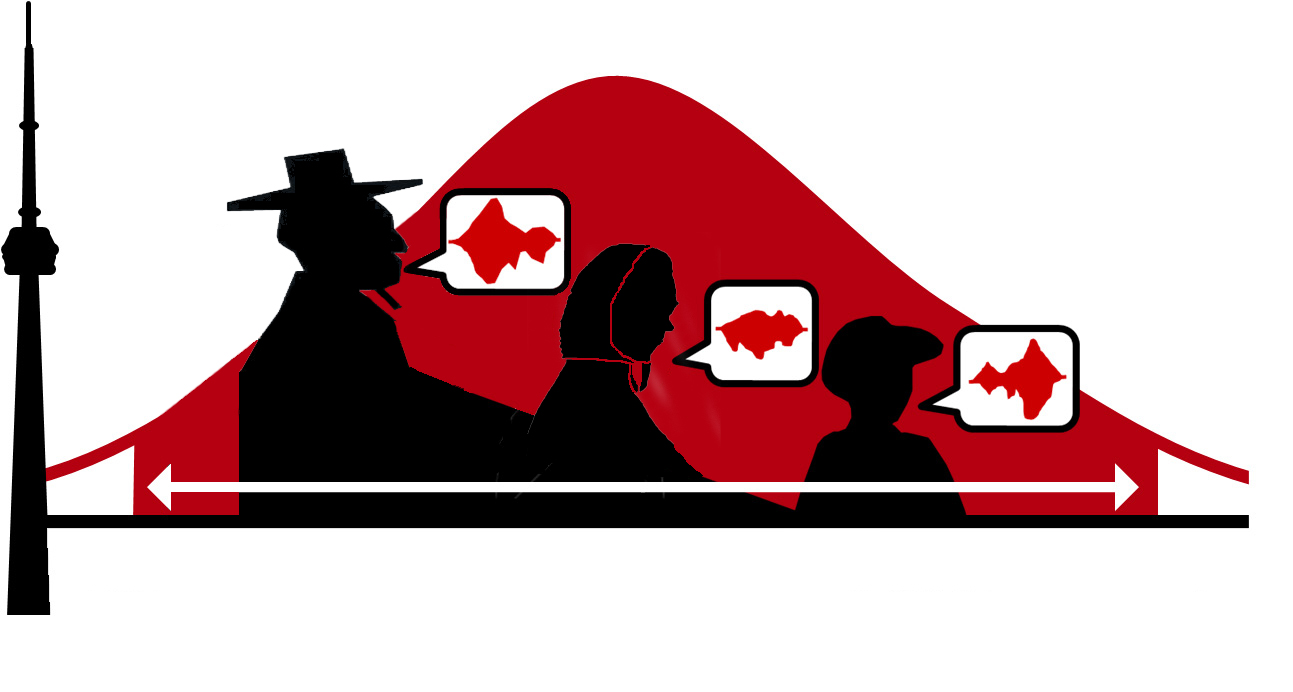Naomi NagyLinguistics at U of T |
|
Project
1: Sociolinguistic Observation & Reporting Due: October 17, 2016 Throughout the first four weeks of the course, keep a journal recording your observations of language use and sociolinguistic variation. Your observations may serve as a source of data for your second project. A number of suggested topics are listed below, but observations relevant to any topic covered in the course are acceptable. Whenever you work with empirical data, it's important to be well-organized and use consistent formats. For this assignment, it's important to organize your observations according to the following format. Each entry should have the following three sections: a) Identifying information: Begin
each entry with an entry number, the date of observation and the relevant topic
or topics. Number all entries consecutively. b) Data: Record
the data (exactly what you observed) as objectively as possible. Do not include
judgments, opinions or comments here. Record the source of each datum: for live
observations, record the date, time, place, participants, situations, etc.. For
written media, include the standard publication information (printed articles
can be cut and pasted but must be cited properly). For electronic media (TV, radio,
internet), record the name of the station (or web site or newsgroup), the
title, the date and time of transmission, etc. N.B. Include here anything about the setting or
participants that may be relevant to understanding why the event you observed
happened the way it did. Write these facts down! c) Comments: Record your own comments, thoughts, interpretations, etc. about the data you have recorded. Why did you notice this particular event? Relate the data to things you have learned in this course. Your comments may include questions that the data raise in your mind, such as, "How do other people say or do this?" or, "Do I say things like that?" You may wish to suggest why you think the event occurred in this way, and how it might have occurred differently with other participants or with same participants in a different setting. Such observations and questions may lead to hypotheses you want to test or to subsequent observations which may ultimately answer your questions. Be ready to record observations at
all times, wherever you go, immediately, as soon as they happen. Don't wait a day, or even an hour,
because the observations will begin fading from your memory, your accuracy will
decline and important elements of the event will be lost. You should have at least six observations
to submit. Each should be about half a page long. Try to focus on just one or two of the
suggested topics. Suggested Topics for Project 1 Code-switching Bilingual
people often mix languages in the course of a single conversation
("code-switching"). Code-switching can take place within the sentence
or between sentences. Record any examples that you notice of people using more
than one language in a single conversation. Be sure to make note of what
languages are involved, and, insofar as you are able to understand those languages,
try to record exactly what was said. Also, if you yourself know more than one
language, note whether you or your family members or friends code-switch, and
make note of any examples you or they produce. In discussing such cases,
consider the following points: Why did the switches occur where they did? What
aspects of the social context permitted or encouraged such mixed use of
languages? What was the reaction of the other participants in the conversation
to the code-switching? Regional and national accents Native speakers of English show many different national and regional varieties ("dialects"). Listen for any form of English spoken by a native speaker that is different from your own. Some examples: Canadian (Newfoundland, Western Canadian, French Canadian), Australian, New Zealand, Irish, West Indian, American (New York, Southern, Californian), British (RP, Cockney, Scottish, Yorkshire). Record and comment on any distinctive features of pronunciation, grammar and vocabulary that you notice. Note your reaction to this dialect: Do you react positively or negatively? What aspects of the dialect affect your reaction the most? If you are a native speaker of another language, you might wish to report on regional or national accent variation you observe in that language instead. Foreign accents In
Toronto there are many immigrants, residents and visitors who are not native speakers of
English. How is English spoken by someone who has learned it as a second
language? Listen for any foreign accents and comment on any differences you
note in pronunciation, grammar or vocabulary. Find out what that person's
native language is. Try to determine what rule or feature of English that
person is not reproducing exactly. Note: If you speak or are learning a second
language yourself, you could compare these observations to your own speech in
that language. If you are a learner, are your mistakes similar to those made by
other people learning English as a second language? Slang and in-group words Slang refers to words and expressions that are
not generally considered part of the standard language, but are used regularly
by members of particular cultural subgroups (e.g., teenagers, computer hackers,
surfers). One reason why such groups use slang terms is to mark their
membership in the subgroup and simultaneously exclude non-members: appropriate
use and understanding of slang forms identifies someone as a fellow member,
while failure to use or respond appropriately will betray them as an outsider.
The same type of in-group use of particular words is found among people of the
same occupation, religion, etc., where the terms are generally referred to as jargon (which is generally not
stigmatized and may be more technical in nature). Collect instances of slang or
jargon that you hear around you, whether or not you are a member of the
appropriate subgroup. Record relevant information about the situation, setting,
topic and participants. Translate the form into a standard English equivalent
and try to characterize the cultural or occupational subgroup that uses this
expression. Male-female differences Collect
observations of ways in which men and women differ in their use of language.
This could include differences of vocabulary, use of polite and euphemistic
expressions, use of taboo words, use of "standard" as opposed to
"nonstandard" words or grammatical constructions, differences in
voice quality and pronunciation (e.g. pitch, breathiness, aspiration, etc.). Do
these differences in usage depend on whether the speaker is addressing someone
of the same sex or someone of the opposite sex? Are these differences the same
for all age groups? Note also any differences in the terms males and females
use to refer to other males and females (e.g. guy, girl/gal, chick,
etc.). How are these terms used to show respect or disrespect? Are they used in
comparable or reciprocal ways across the two sexes? Does the use of these terms
depend on age and social position? What words are used to refer to mixed groups
of males and females? Ethnic differences Some
features of English are often associated with speakers of particular racial or
ethnic groups, stemming either from originally foreign accents (e.g. recent
immigrant groups) or from historical segregation (e.g. African American
English). Often these features have become positive connotations as markers of
identity in the ethnic/racial group. In collecting observations of such
features, be careful to distinguish between conventional stereotypes of the way
these groups talk and what you actually observe people saying. (These are
usually not the same thing!) Carefully explore your own preconceptions about
how ethnic/racial groups different from your own speak. Social class differences Collect
observations of differences in the use of language by people of different
social classes (which may be treated as a cover term for differences in
education, occupation, status, income, etc.). Be on the lookout for usages that
strike you as nonstandard, stigmatized, 'common' or uneducated vs. those that
seem pretentious, upper-class, sophisticated, etc. Again, this could involve
vocabulary, pronunciation or grammar. Taboo words Most
languages have a number of words that are socially taboo, and in certain
circumstances even legally prohibited, referred to as "swear words"
or "dirty words". Many have central meanings related to bodily
functions (e.g. piss), body parts
(e.g. prick) or religious concepts
(e.g. goddamn), but are often used in
ways that have nothing to do with the central meaning. Such words also show
considerable gradation in the degree of tabooness. These facts mean that there
are powerful social conventions about the situations in which they may be used,
the people to whom they may be uttered and even the people who are allowed to
say them. Thus, you don't use them in formal situations (e.g. lectures) and in
the presence of certain people (e.g. mothers, priests), and certain people are
expected to use them less or not at all (e.g. women, young children). Record
your observations of the use of such terms, paying special attention to the
speaker and other people present (sex, age, class, etc.), the situation and the
meaning or intent (to express emotion, to insult). Comment in particular about
what it was about the situation which allowed these words to be used, given the
strong social taboo about the use of such words in certain situations. Note
also the reaction of those present, including yourself. Media attention to language The
mass media (newspapers, radio, TV, magazines, the worldwide web) often run
articles, stories or programs about language, including news items, interviews
with "experts", opinion columns, talk shows, letters to the editor,
etc. These usually concern the nature or quality of present-day English (what's
wrong with it, what it sounds like), the decline of standards (how corrupted
the language is becoming), new words in the language (slang, borrowings,
neologisms) and new meanings for old words. If you hear or see something like
this on TV or the radio, take notes on what is said; if you see an article in
print or on the web, photocopy it, print it or cut it out and paste it in your
journal. Comment on the following points: Do you agree or disagree with the
opinions expressed? Did the author overlook any relevant facts? Do you think
the person was fair or biased? In what way? Are the opinions expressed similar
to or different from the point of view taken in the course? In what way? Style-shifting All
speakers adapt their way of speaking to different audiences, topics and
settings. They can speak formally in public, professional or official contexts
(e.g. classrooms, business meetings, public speeches), or they can be informal
in private and personal contexts. They can show politeness and deference to
social superiors (e.g. teachers, employers) or assert authority over social
inferiors (e.g. employees, children). They can demonstrate familiarity or
intimacy (e.g. friends, family) or distance (e.g. strangers). This dimension of
variation in language use is often described as "speech style" and
when a speaker changes from one style to another, it is referred to as
"style-shifting". Make note of any examples of style-shifting that
you encounter. This may be especially noticeable in contexts where speakers are
relating to different audiences in rapid succession. For example, in a
classroom setting, students may use one (formal) style to speak to the
professor or to contribute to a classroom discussion, and a different
(informal) style to carry on a private conversation with a friend in the class.
At home, you may speak more formally to your parents than to your siblings. For
observations of style-shifting, be sure to make note of the social relationship
between the speaker and the addressee(s). Also, try to characterize the nature
of the speech style used in each setting or with each audience in terms of
(in)formality, familiarity/distance and politeness. A Small Study of Sociolinguistic Variation Due: November 30, 2016 (Week 12, hard copy due in tutorial) In
this assignment, working individually or in groups of up to 3, you will study
the use of a sociolinguistic variable. You may collect data by means of
participant observation (i.e. by noting relevant examples of the feature you
are studying whenever they are used in your presence) or use existing data as specified below. You may choose any one
of the suggested topics to work on, or suggest a variable of
your own after consulting with the
professor. You may use observations from Project 1.
Step 2. Data Collection
Over
a period of a week, each person should collect a minimum of 25 tokens (occurrences) of the variable. A good practice
is to keep a notepad with you at all times, so that whenever you hear somebody
using the variable, you can write down which variant they used, as well as
other relevant information about the situation: • sex of the speaker: -
try
to obtain roughly equal numbers of tokens from males and females • sex of addressee/hearer (including
yourself) • familiarity of speaker and
addressee/hearer -
distinguish
‘familiar’ interactions (friends and family members) from ‘less familiar’
interactions (acquaintances or those in a formal relationship, such as
student/teacher or employee/employer) -
try
to obtain roughly equal numbers of tokens from familiar and unfamiliar
interactions -
make
note of other features of the context that would make the interaction more or
less formal, such as the topic of conversation and the setting • channel of communication: -
make
note of whether each token occurred over the telephone or internet vs.
face-to-face, through speech vs. writing, through participant observation vs.
questionnaire, etc.
Although Prime Minister Justin Trudeau has gotten a lot of media attention in his first year in office, sociolinguists have yet to publish any analysis of his speech, as far as I know. Many questions come to mind:
To answer one of these questions (or a similar one that the professor has approved, you need to find recorded and/or transcribed speech. This choice depends on what kind of variation you want to examine. You will need at least 3 minutes of speech to examine. Many samples exist online.
If
you/your group is able to work with spoken recordings of one of the languages
in the
(Heritage Language Variation and Change project), select a minimum of three
speakers that have been recorded and transcribed. Find at least 25 tokens
(occurrences) of the variable in each recording. A good practice is to create
additional tiers in the ELAN .eaf file and mark and code the tokens there. In
one tier, note which variant they used. In additional daughter tiers, note the other
relevant information about the situation (see list in Option 1). The tokens and
tiers can then be exported to a spreadsheet for easy analysis.
Step 3. Data analysis Summarize
your results in the form of tables, showing what proportion of tokens of each
variant you encountered (e.g. formal vs. informal greetings, -ing vs. -in’) were uttered by males as opposed to females, addressed to
people with whom the speaker was familiar vs. unfamiliar, were spoken over the
telephone vs. face-to-face, etc. Consider carefully how your different variants
might best be grouped together. (e.g., Are some of the greetings more formal
and others more familiar? Are some taboo words extremely taboo and others only
mildly so?) If you identify groupings like this in the data, use them in your
tables. Wherever possible, express your results as percentages, calculating
proportions within each category. For example, what proportion of familiar
greetings were used by men vs. by women? Step 4. Research Report Write
a report (4-5 pages) describing your study. It should include an informative
title and the following short sections in order: i)
Introduction State
the variable, what the variants were and why this was interesting or what
general issues it related to (i.e. your goals and hypotheses). ii)
Methodology Describe
how you collected, coded and analyzed the data. iii)
Results Organize
your research findings into tables broken down by social categories (sex,
familiarity, etc.). iv)
Discussion Discuss
your results and their implications. Think about questions that have been
addressed in the class. Make explicit reference to at least two of the assigned
articles, as well as relevant concepts from the textbook. Address questions
such as the following: Do men and women show different preferences for the
various greetings or leavetakings, or pronunciations of -ing? Do men use more strong taboo words than women? Do women use
more information-seeking tags than men do? Do speakers use different greetings
or leavetakings over the telephone than in person? Do people code-switch more
often with people they know well as opposed to those they have limited
acquaintance with? Does pronunciation of -ing
vary with the formality or familiarity of the situation? v)
Conclusion Try
to draw general conclusions about your results. Why did the results come out
the way they did? Why do (or don’t) women and men differ in the use of these
features? Why do speakers use different forms in different interactions? Where
possible, try to identify future areas for possible research. vi)
Bibliography List
all published references, including websites, that you consulted. Cite them
appropriately within your paper. There are resources in the course Blackboard
site for help on citation and reference practices. Evaluation Evaluation
of the assignment will be based on the following considerations: Structure: -
organization;
clarity; spelling and presentation (use a
spell-checker!) Content: -
how
well have you defined the variable context (i.e. where does the speaker have a
choice between variants?)? -
how
well have you discussed your methods of data collection? -
how
well have you discussed the details of your quantitative analysis (your social
factors, your calculations)? -
how
well have you made use of tables and graphs? -
how
well have you synthesized and interpreted your results? -
how
well have you made connections between your results and the course materials
(textbook, readings, lectures)? If you work in a group, you
will submit one co-authored paper.
Be sure that the title and all authors' names are listed at the top of page 1. You do not need to create a separate title page. You are encouraged to print two-sided. Greetings and/or
Leavetakings When
people encounter one another after a period of not being in each other's
presence, they normally use some kind of greeting (e.g. hi, hello, good morning); similarly, when people
terminate an encounter and expect not to be in each other's presence for some
time, they ordinarily mark this with a leavetaking (e.g. goodbye, see you).
Greetings and leavetakings mark different social relationships between speaker
and hearer. Make note of all greetings and/or leavetakings addressed to you or
to others in your presence and try to characterize the social significance of
each (i.e. which ones are more or less formal, express solidarity or
familiarity, etc.). You may want to divide your greetings/leavetakings into two
variants: ‘formal’ and ‘informal’. Try to characterize any preferences that
different speakers or groups of speakers tend to have (e.g. Do men use informal
greetings more than women?) and whether usage is affected by the channel of
communication (telephone vs. face-to-face). Taboo Words Taboo
words (commonly referred to as "swear words", "curse words"
or "dirty words") are subject to strong social conventions about
their usage. Note all instances of such words that are used in your presence.
You may want to divide the different taboo words into two variants: ‘mild’ and
‘strong’. Try to characterize
whether men and women use taboo words differently and whether people are more
or less likely to use them in the presence of people they know well as opposed
to those they are less familiar with, or in the presence of women as opposed to
men. Tag Questions Robin
Lakoff (1975) has suggested that women use tag questions more than men because
tags signify a desire for confirmation or approval and therefore relative
powerlessness or lack of self-confidence (e.g. It’s a nice day, isn’t it? is supposedly less assertive than It's a nice day.). Collect observations
of male and female speakers using tag questions. You may want to divide the tag
questions into two variants: ‘polite/deferential’ and ‘seeking confirmation’.
Note especially when the tags are used differently from the way you would use
them. In your analysis, discuss whether your data confirm Lakoff’s hypothesis
or not; i.e. do men and women use these forms with different frequency or
different significance? -in/ing The
-ing suffix in English (e.g. building, running, opening) is
sometimes pronounced as 'ing' and sometimes as 'in' (known as "dropping
the 'g'"). Since the social evaluation of each pronunciation is different,
speakers often vary their usage according to formality, and speakers of
different social backgrounds may show different overall rates of usage. Data
collection for this feature requires close attention to phonetic detail:
practice listening to the pronunciation of -ing
words in conversation before you begin collecting data. (When you begin writing
down your observations, they will probably occur so frequently that you will be
able to collect enough data to work with in a day!) Therefore, try to observe
people from a range of social backgrounds. In
addition to social variation, this variable is also subject to an interesting
linguistic constraint. To examine this, you should classify each example you
observe as to whether it was used as a noun (e.g. the building across the street, running is fun) or a verb (e.g. we're building a house, he's running to work). Your analysis
should address the following questions: Is there a sex difference in the usage
of the two pronunciations? Do speakers shift towards increased use of one of
the pronunciations in more formal situations (e.g. lectures) as opposed to
informal ones (e.g. casual conversation)? Is there any such shifting depending
on the sex of the addressee or the channel of communication? |



